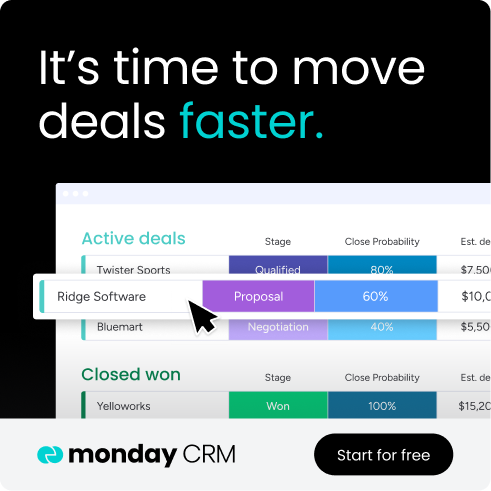Generating leads without tracking them in a pipeline is like filling a leaky bucket. You’ll never know where opportunities are slipping away or why your effort isn’t translating into results.
In this article, we’ll look at what pipeline management is, share best practices for success, explore real-world examples, and show how monday CRM connects it all through visual, AI-powered pipeline management.
Try monday CRMWhat is sales pipeline management?
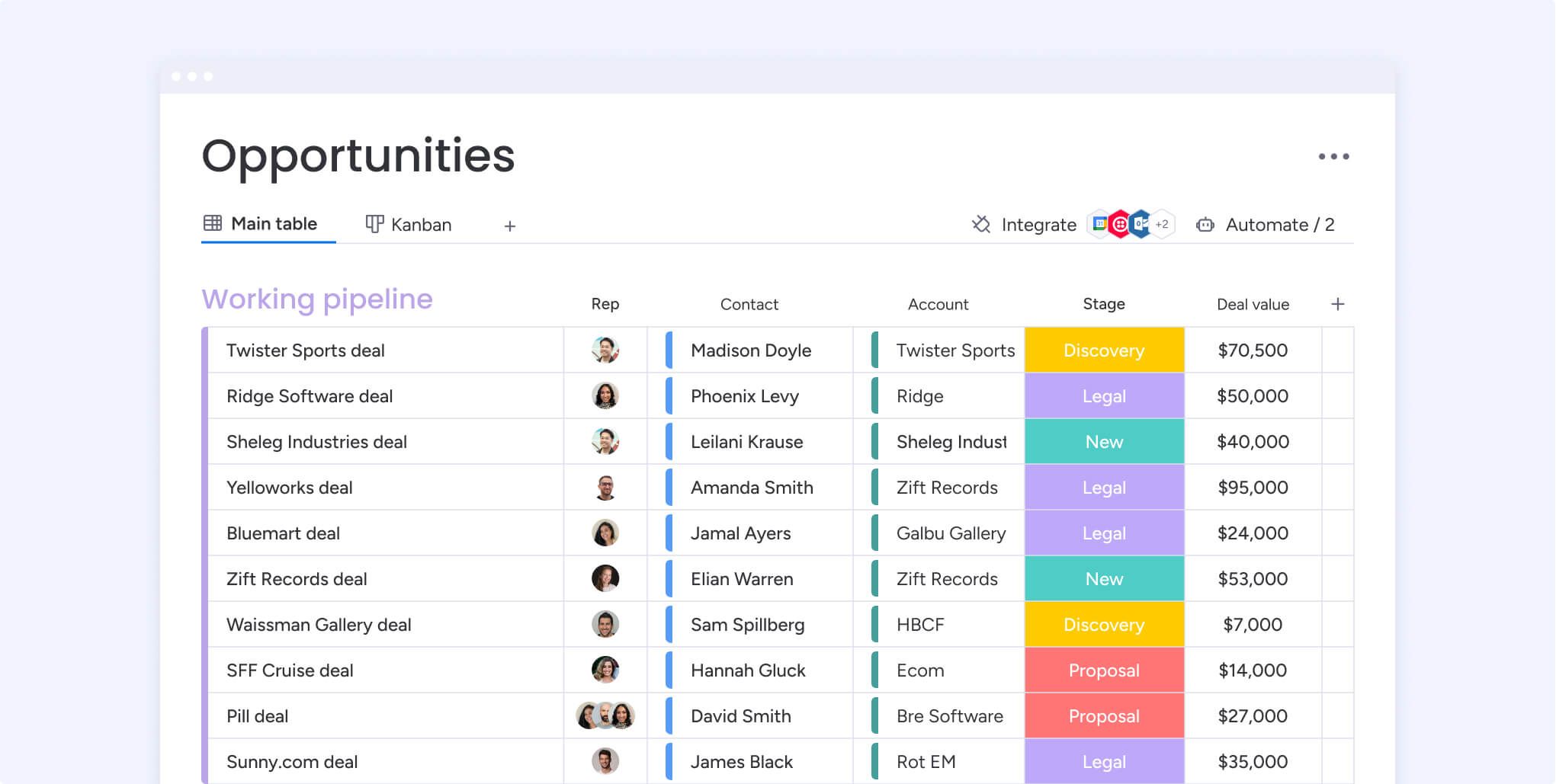
Sales pipeline management is the practice of overseeing, directing, and optimizing leads and sales opportunities as they move through each stage of the cycle. Your sales pipeline displays potential customers’ journeys from initial contact to closing and even post-sales.
Managing your pipeline involves analyzing, improving, and supercharging your sales processes to attract more revenue. On a practical level, sales cycle management includes:
- Splitting your pipeline into segments and assessing for any bottlenecks
- Using key metrics to measure your pipeline’s performance
- Allocating resources where they’re needed most
- Regularly updating your pipeline data
- Reviewing real-time data to inform decision-making
- Analyzing failures to make better choices in the future
When done well, sales pipeline management allows your company to grow sustainably by establishing results-oriented ground rules and strategies that improve sales.
Often, teams use sales pipeline software to easily manage and visualize everything in one place and keep team members all on the same page.
Clarification: In other industries, “pipeline management” refers to monitoring physical pipeline integrity (like in oil and gas). In this article, we’re focusing on sales pipeline management — tracking and optimizing deals through each stage of the sales cycle.
Sales pipeline vs. sales process: What’s the difference?
A sales pipeline and sales process are closely related, but represent two different things.
- A sales process is the repeatable set of processes and actions that sales reps follow to move a prospect from initial contact to a closed deal.
- A sales pipeline is the visual representation of where all your active deals currently sit within that process at any given moment.
Think of the sales process as the roadmap that every deal should follow, while the pipeline is the snapshot showing which deals are at which milestones along that route. A business may have an excellent sales process but still suffer from a poorly managed pipeline, or vice versa.
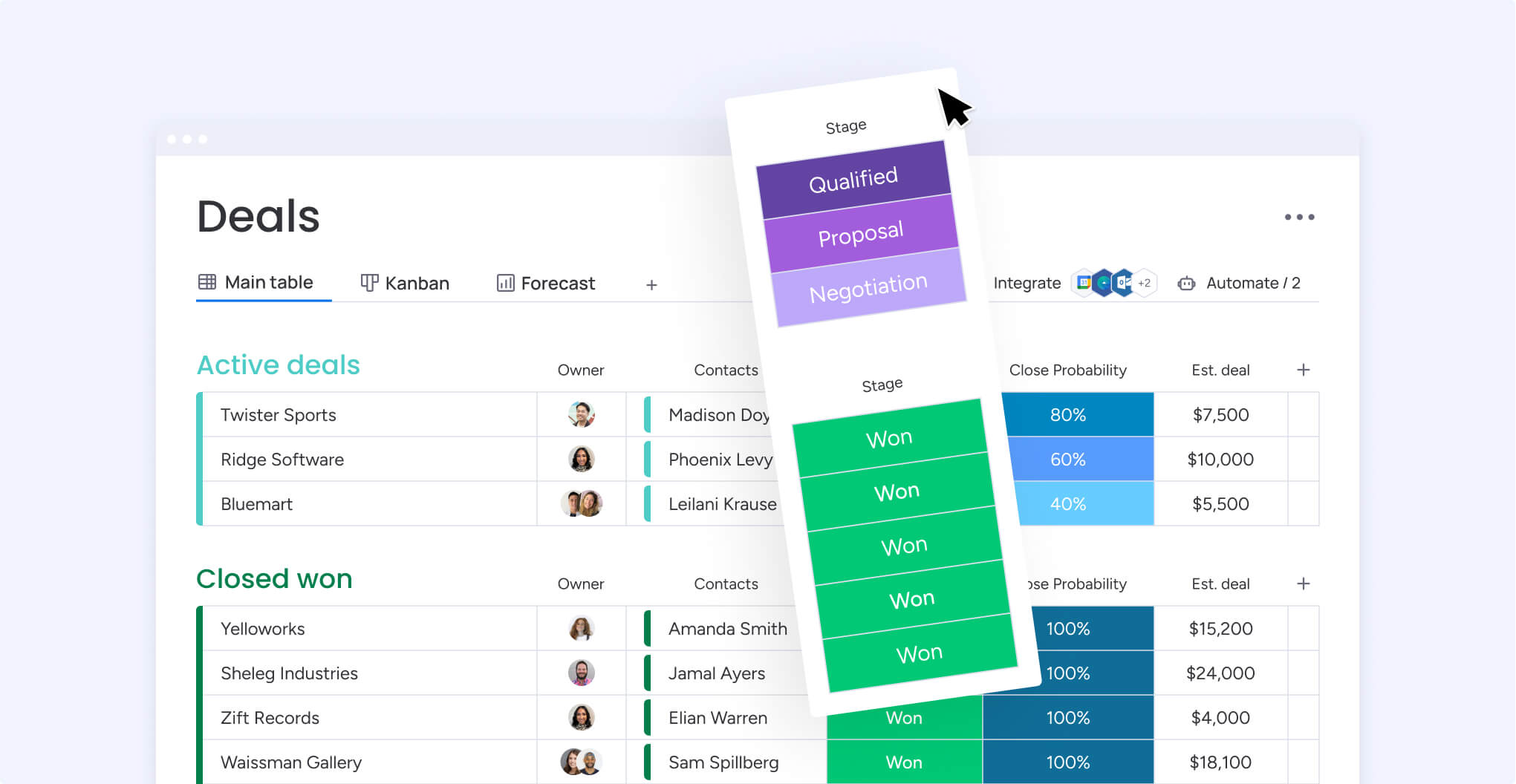
The 8 stages of the sales pipeline cycle
Properly managing your pipeline involves a sales professional or pipeline manager tracking activities that pull people through your pipeline stages. To better understand how to construct your sales pipeline, here’s a look at the 8 different steps to turn a lead from a prospect to a customer.
Note: These stages may look different depending on the industry you’re in or the products or services you sell. We’ll break down a few more sales pipeline examples elsewhere in this article.
1. Prospecting
Prospecting involves identifying potential customers who may be interested in your product or service. This may result from conducting market research, generating leads through marketing initiatives like social media campaigns, website sign-ups, referrals, or cold emailing.
2. Lead qualification
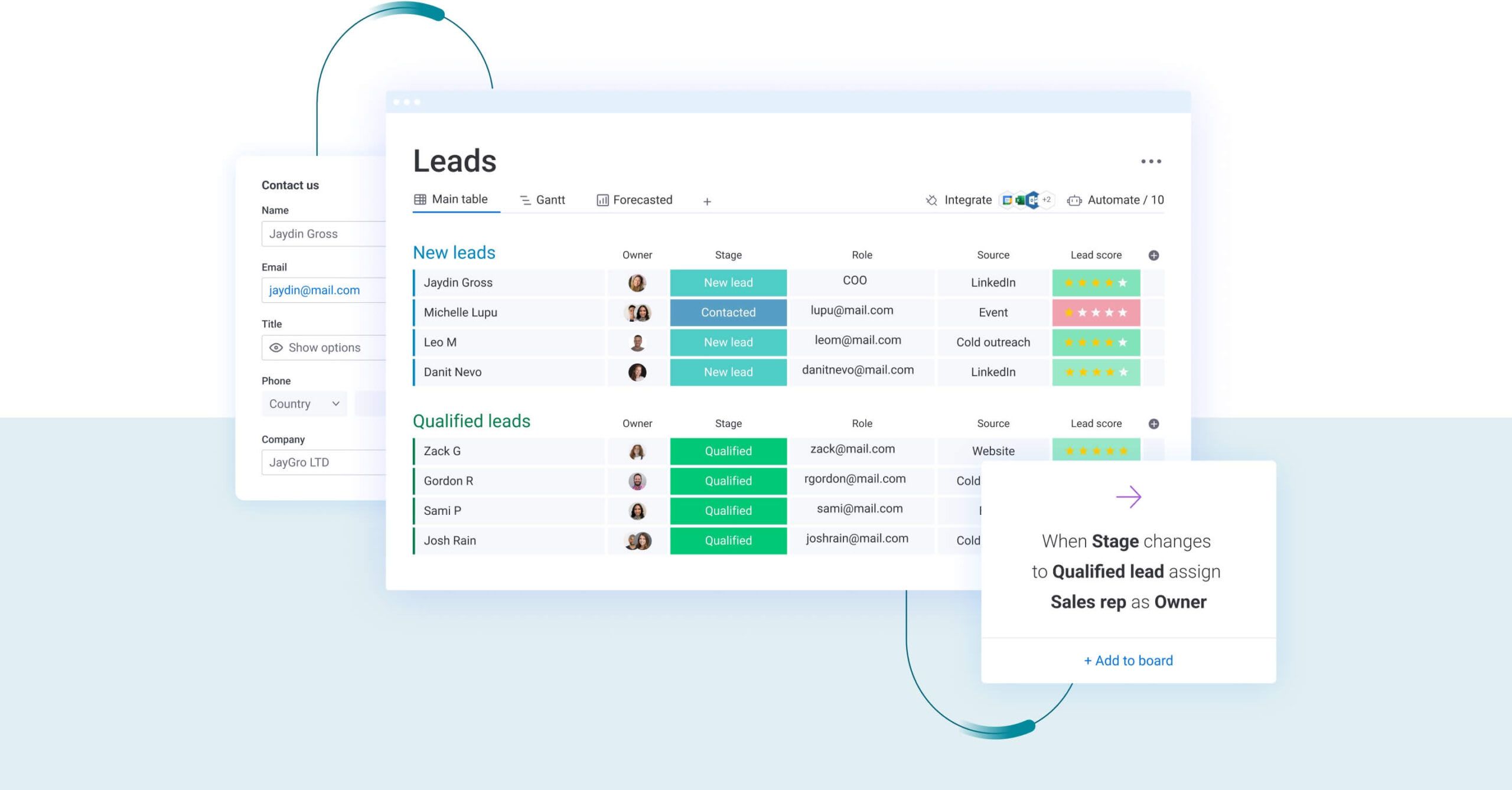
The next step of your sales pipeline is where you evaluate the likelihood of each lead turning into a customer. This step helps weed out the leads who either aren’t a good fit for your company or aren’t likely to convert so that your team can focus on high-value prospects.
You want to evaluate or score leads based on criteria such as budget, authority, need, and timing (BANT). Smart solutions like monday CRM can do this automatically without manual intervention, speeding up your pipeline.
3. Initial contact
Start the conversation by contacting qualified leads to introduce your product or service. Depending on your product or service, this isn’t typically the stage of your pipeline where you want to go in with a hard sell.
Sales professionals often use this as a fact-finding mission to understand the potential customer’s pain points and then build a sales strategy that will work for them.
4. Nurturing
Nurturing prospects can be a long game that involves multiple conversations and questions. The process involves personalizing content like emails and sales pitches, product demos, and meetings to address issues.
It can take time for leads to develop trust in the brand, and for sales professionals to deeply understand the problem their products or services can solve.
5. Proposal
This step of the sales cycle is all about presenting a tailored, formal proposal that highlights how the benefits and features of your product or service are the solutions your leads have been looking for.
You might run a demo, meet in person to run the lead through your product or service, or address different ways your business can solve their pain points.
6. Negotiation or objection handling
If the lead has any objections, concerns, or needs to make any changes to your proposal, this happens during the negotiation stage. The negotiation can also be about the terms of the sale or the contract, including deliverables, deadlines, or costs.
7. Closing
In this phase of your pipeline, a formal agreement or purchase order signals that the lead has successfully turned into a won client and that the deal has closed. Some people consider this the final stage of the sales pipeline, handing off to the customer success team to begin onboarding.
8. Post-sales
This final stage focuses on ensuring customer success and identifying upsell opportunities. You might transfer your new customer to the customer success team for onboarding or post-sales care so that they have the best chance to succeed with your product.
Post-sales is also an excellent time to send out customer feedback surveys or prime your customers for up-selling or cross-selling opportunities.
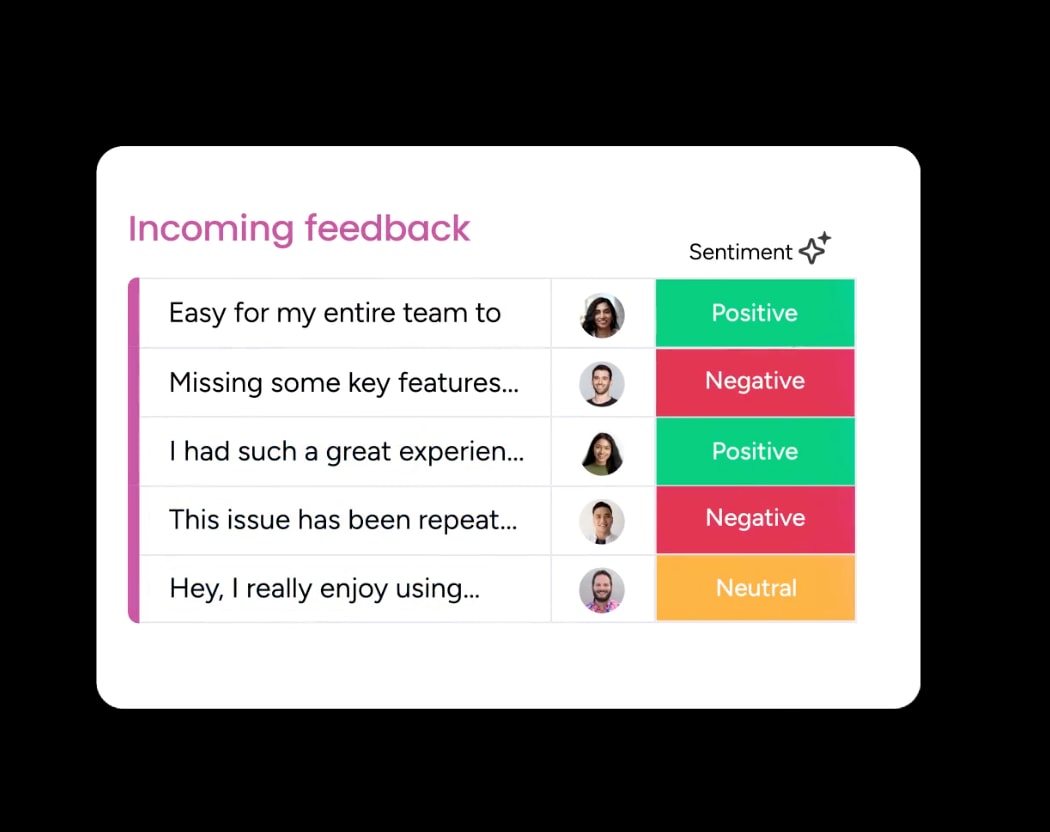
4 examples of sales pipelines by industry
You may know what a sales pipeline does, what it looks like, and the stages it involves, but how do they actually function in practice? Above, we looked at a typical sales pipeline that could be applied to many scenarios, including a B2B sales and a SaaS pipeline. However, some industries may require longer or shorter pipelines based on the complexity of each deal.
To see how this framework applies in real-world settings, here are examples from 4 major industries:
1. E-commerce pipeline
- Website visit
- Product browsing
- Add to cart
- Checkout
- Payment processed
- Order fulfilled
- Customer support or repeat purchase
2. Real estate pipeline
- Lead inquiry
- Initial consultation
- Property showing
- Offer preparation
- Negotiation
- Home inspection
- Financing approval
- Closing
3. Financial services pipeline
- Inquiry
- Introductory meeting
- Financial assessment
- Risk profile analysis
- Custom plan presentation
- Account opening
- Funding
- Ongoing relationship management
4. Manufacturing pipeline
- Lead identification
- Initial contact
- Technical needs assessment
- Site visit
- Custom quote
- Prototype approval
- Negotiation
- Purchase order
- Production and delivery
- Quality assurance
Benefits of results-driven pipeline management
Sales teams can gain a lot by establishing a comprehensive pipeline with the right software. Once set up with the right automations, managing your pipeline becomes a seamless part of daily operations
Here are a few core ways teams can benefit from smarter deal flow management:
Better forecast team performance
Sales pipelines are a great way to get a visual overview of where your sales currently stand so that you can forecast future deal closures. This helps sales managers assess whether their team will meet sales targets or if resources need to be shuffled to attain quotas.
Improve team productivity
Sales teams that work with pipelines are always aware of what comes next. Rather than wasting time planning out sales tasks, it’s very clear about what actions should be taken based on where a deal is in the pipeline.
Decrease bottlenecks and errors
When sales teams have more visibility into their sales funnel, it’s easier to avoid costly mistakes and bottlenecks. For example, a sales manager may notice that deals often get stuck in the negotiation stage and then take action to simplify processes in this phase to speed things along.
Enhance the customer experience
Teams can improve customer satisfaction and create a more seamless overall customer experience by navigating each deal with a pipeline. When sales agents understand where each lead is in a pipeline, they can be more proactive about resolving issues and offering the right content or suggestions at the right time.
Streamline sales collaboration
Handing off leads or deals between sales agents is a lot smoother when everything is clearly tracked with sales pipeline software. For example, if every rep in a sales team has the same access to the team pipeline, a senior rep may notice a new rep’s deal is stalled in the pipeline and jump in with insights and recommendations.
5 pipeline management best practices
Managing the sales cycle requires ongoing attention. If every sales rep is doing their part in keeping a pipeline updated, everything should flow smoothly. To make things even easier, follow these best practices to get the most out of your pipeline management:
1. Always be prospecting
Prospecting may seem like a no-brainer, but busy sales reps can take their foot off the gas when their sales pipeline appears full. Following the process and keeping prospecting activity levels high is the only way to ensure your pipeline stays full, blows past sales goals, and sets new records.
2. Make follow-up a routine practice
The days of one-call closes are practically over. According to market research from Outreach Insights Group, sales cycles are getting longer, with 34% of revenue teams reporting an average sales cycle of 1-2 full quarters. On top of that, opportunities closed within 50 days have a 47% win rate versus 20% or less after that threshold.
Prospects are constantly being bombarded by calls and emails from your competitors, who are all vying for their attention. Following up regularly and providing value is the only way to cut through the noise.
Slipping seamlessly into your pipeline management, software like monday CRM can automate parts of the process by sending automated follow-ups and personalized messages using AI at predetermined intervals.
3. Focus on a few critical pipeline metrics
The number of key performance indicators (KPIs) your company could track is staggering. There are hundreds, if not thousands, of possible metric combinations that might improve your bottom line. What matters most is picking metrics your reps, leaders, and stakeholders understand and that align with your company’s overall strategy.
Some common metrics to consider include:
- Average sales velocity: How quickly leads move through your pipeline.
- Average deal size: Total revenue over a set period divided by the quantity of closed-won opportunities.
- Pipeline total value: The combined value of all opportunities at each sales cycle stage.
- Win rate: The percentage of prospects that convert to customers divided by all deals in the pipeline for that period.
- Lead response time: How long it takes to follow up on a lead.
Once you’ve determined which KPIs to measure, make sure to track them all with reports, dashboards, and analytics in software like monday CRM.
Try monday CRM4. Automate repetitive workflows
You hired your sales reps to sell, not to do admin work, which is where sales automation comes in. Automations can serve different purposes at each stage of your pipeline. For example, you might use automation to notify a sales team member once a prospect’s lead score reaches a certain threshold.
Later down the pipeline, when leads are already warm, you can create automations to send personalized follow-up emails after demos, schedule reminders for contract reviews, or instantly update deal phase when key actions are completed. Thanks to automations, you can free up your reps to focus on high-value conversations instead of manual data entry.
5. Regularly clean up your pipeline
Your sales cycle can decay if you don’t maintain it. Imagine that a sales proposal was presented to a lead for $8,000 last year, but they haven’t picked up the phone or engaged with any emails since. You may assume the opportunity has faded. This potential customer has lost interest, shifted priorities, or purchased already.
If you leave the opportunity in your pipeline month over month, not only is your sales forecast skewed, but your team wastes time and mental energy on deals that will never close, obscuring the real opportunities that deserve attention and resources.
High-performing pipeline management requires cleaning and maintaining your sales opportunity list and setting time-sensitive follow-up deadlines.
The role of a CRM for sales pipeline optimization
While spreadsheets and manual tracking can work for very small teams, scaling requires visibility, automation, and data-driven forecasting — exactly what customer relationship management (CRM) software provides.
CRM software gives teams the ability to automate any stage of their deal flow, track prospect interactions, generate accurate forecasts, and seamlessly collaborate — all in one platform.
Sales agents can optimize pipeline management practices using a unified platform that acts as a single source of truth for the entire team, keeping everyone aligned on deals so that nothing gets forgotten.
Supercharge your pipeline management with monday CRM
Effective pipeline management is about creating a repeatable process that produces consistent results for your sales team. Feature-rich pipeline management software like monday CRM enables you to visualize every stage in your process and proactively nurture relevant opportunities toward the finish line.
Built on top of the monday.com Work OS, monday CRM is a purpose-built, industry-specific AI-powered CRM that provides deep and comprehensive workflows for sales and customer-facing professionals.
Teams can cultivate long-lasting customer relationships while also managing their pipeline and using advanced insights and analytics to improve each stage.
Let’s take a closer look at some of monday CRM’s features that make it a leading platform for sales pipeline management.
AI-powered pipeline automation
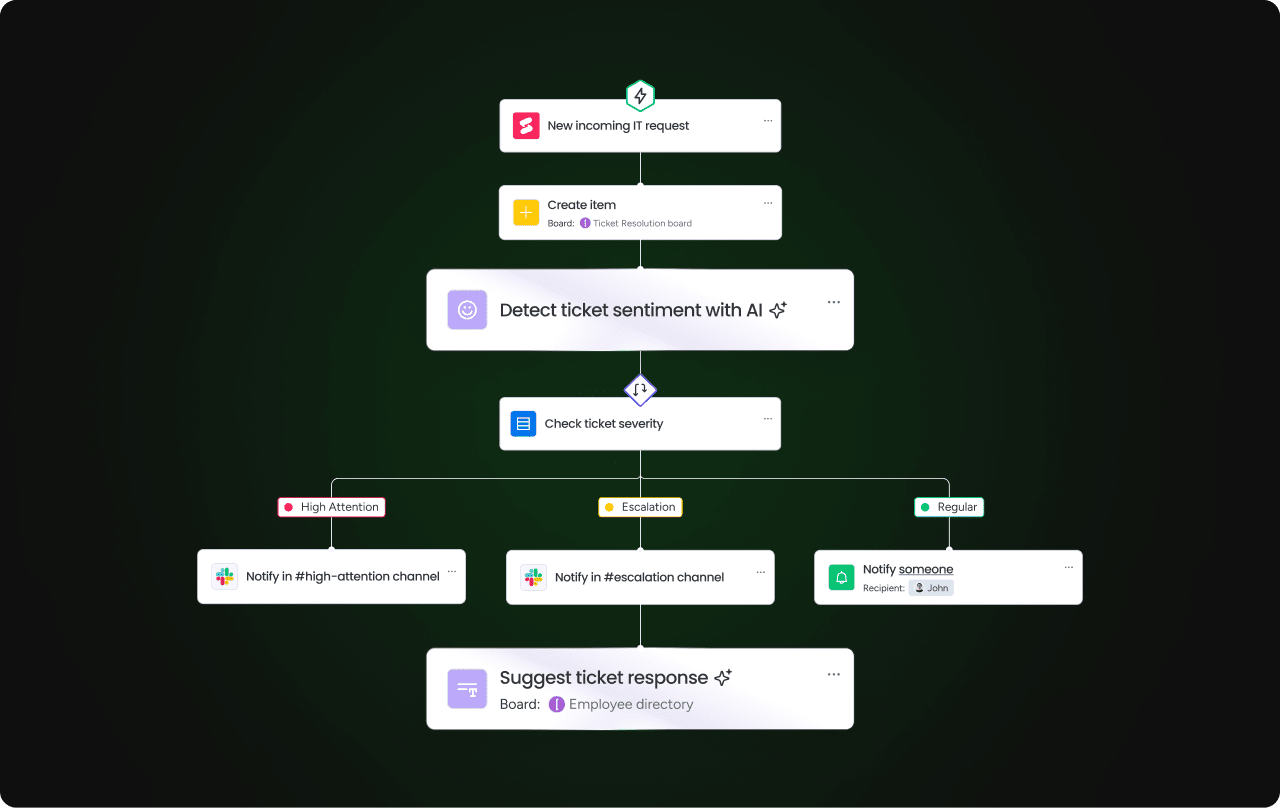
Create CRM automations based on specific triggers and conditions, such as moving opportunities to different groups or assigning them to specific team members. Thanks to monday CRM’s built-in AI, automations are smarter than ever and can be used to predict deal outcomes, suggest next-best actions based on historical patterns, and even draft personalized follow-up communications.
Smarter campaigns based on pipeline data
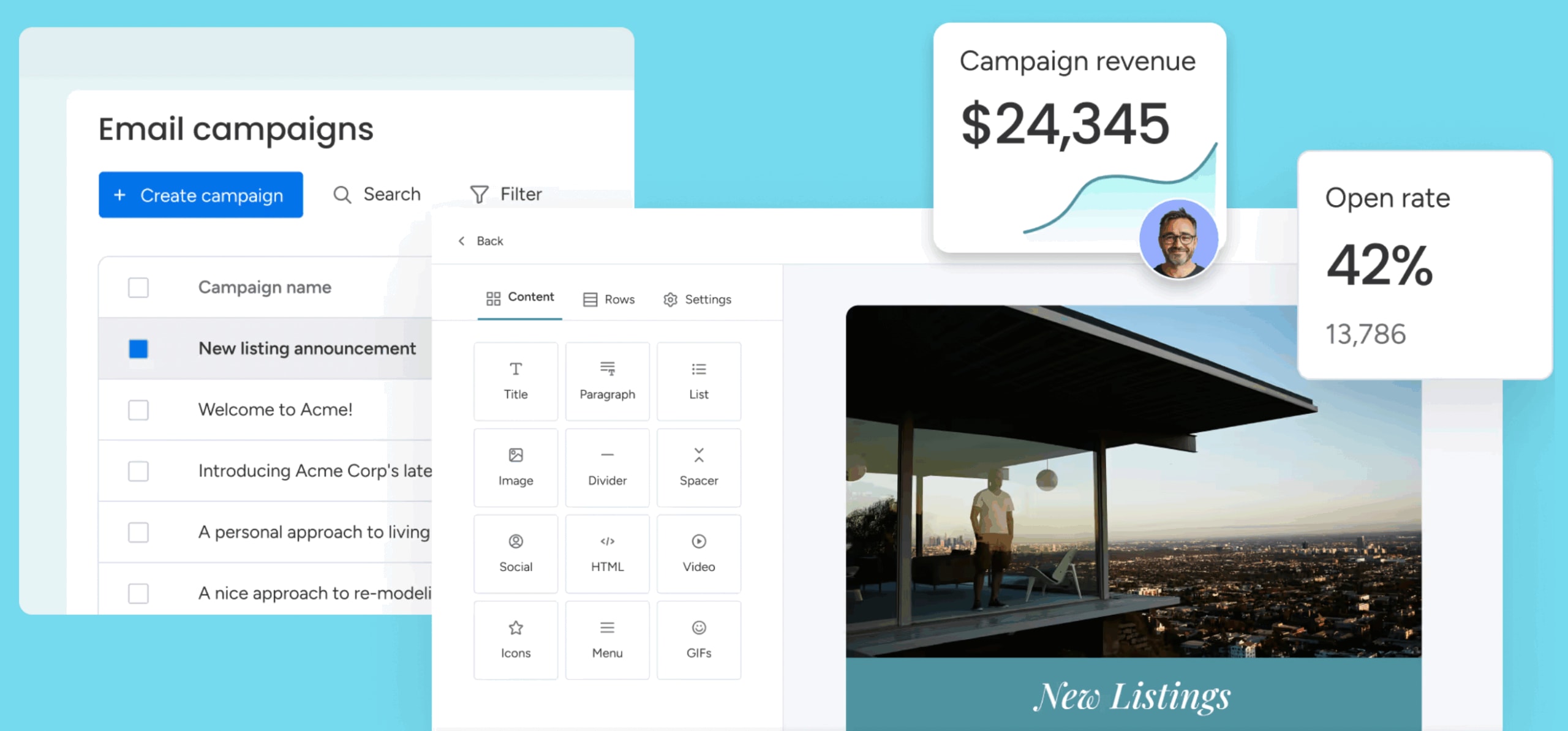
With monday campaigns, teams can create smart marketing and email campaigns that use information from your pipeline to reach more prospects. Sync sales and marketing with essential data from your sales pipeline that can be turned into insights that inform winning marketing campaigns.
Customizable and visible pipeline management
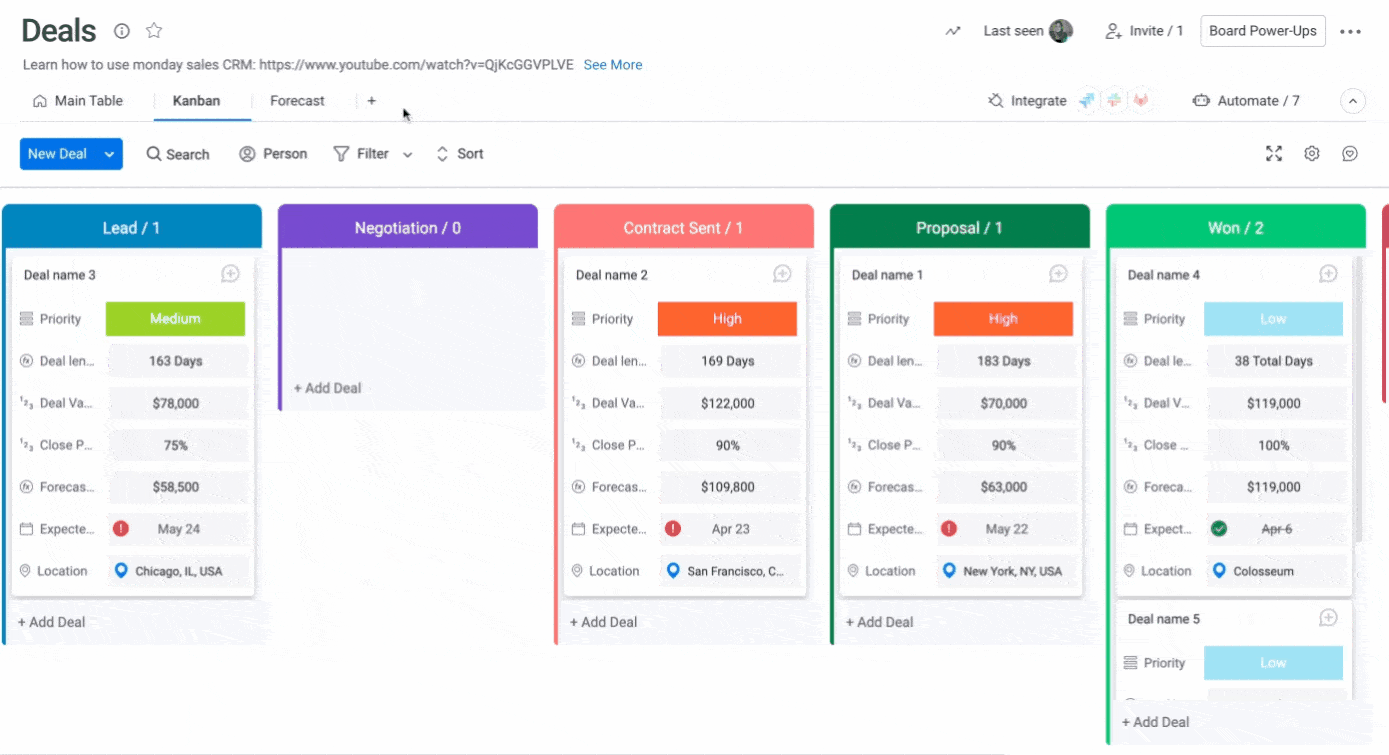
Visibly manage your entire sales pipeline from start to finish and customize how you view your deals. Customize your pipeline with elements like Funnel Charts, which allow you to see pipeline conversion rates at different stages in the funnel, or a Deal Stages widget for a 360-degree view of your pipeline opportunities.
With 27+ dashboard views, 36+ columns, and 25+ widgets, you can set up your pipeline with the exact intel you need to manage your sales.
Automated email powered by AI
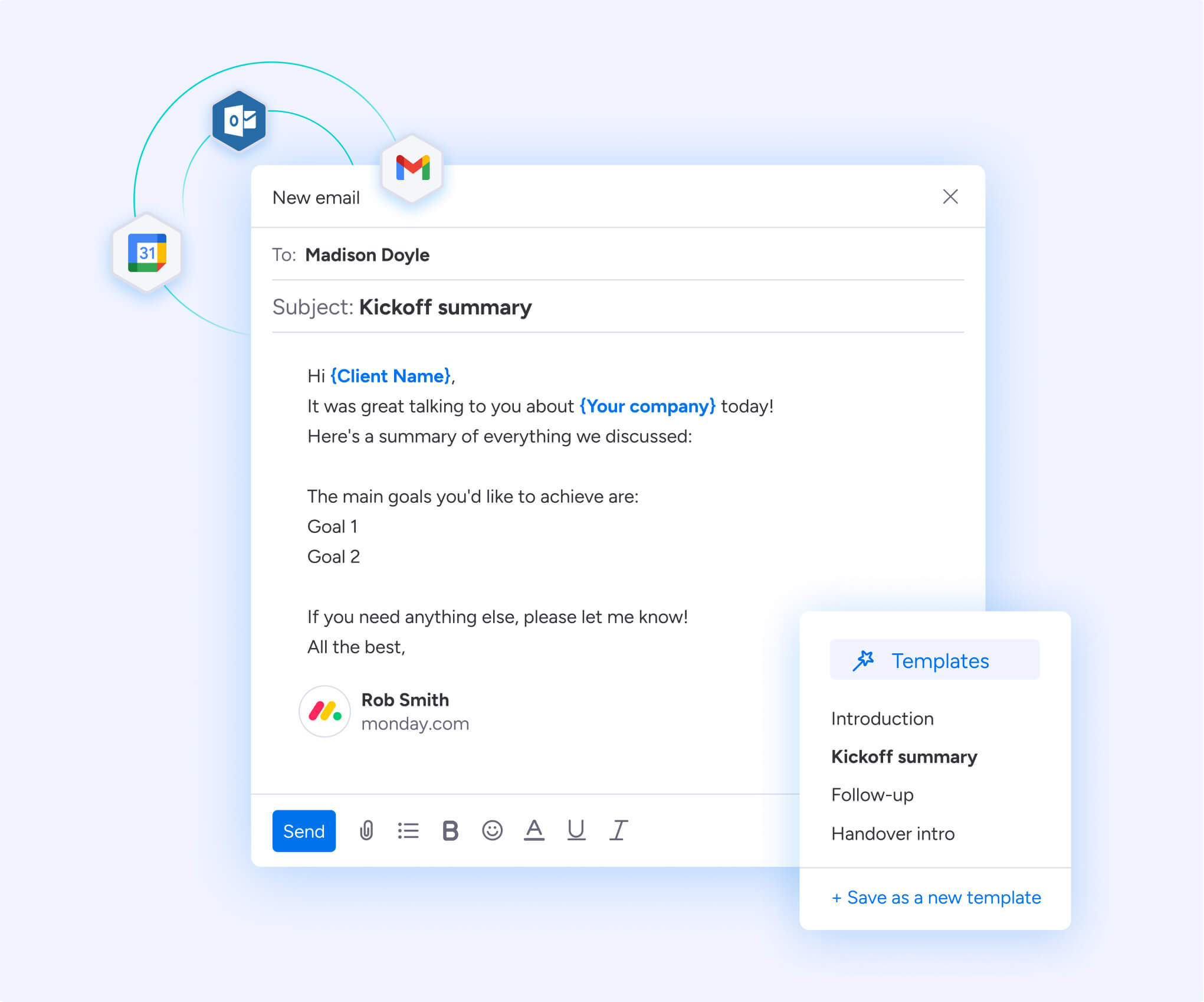
Artificial intelligence is built into our platform, making it easy for sales pros to send thousands of emails to leads and prospects in their pipeline. This high-converting feature saves time while personalizing the message content according to the customer data you have stored in monday CRM, creating communications like follow-ups that are relevant to each stage of your pipeline.
Try monday CRMOvercoming common roadblocks for a successful pipeline
Establishing your sales pipeline shouldn’t be difficult if you follow best practices and build it according to the stages outlined above. However, there are still roadblocks to look out for that can impact the success of your deal flow.
To get your team started on the right foot, make sure to look out for these pipeline challenges and how to overcome them.
Challenge: Poor data hygiene
Outdated contact information, duplicate lead records, and stale opportunities can clutter your real opportunities.
Solution: Make sure to consistently clean and update your pipeline or use a data enrichment tool to keep contact data relevant.
Challenge: Inconsistent stage outlines
When each member of your sales team interprets pipeline stages differently, things can get messy.
Solution: Ensure your team is clear on what each stage entails and what the requirements are for moving a lead to the next stage.
Challenge: Inadequate lead qualification
Unqualified leads clog up your pipeline and waste resources.
Solution: Get your team used to removing unqualified leads from the early stages of a pipeline to avoid bloating and unrealistic opportunities.
Challenge: Unrealistic pipeline goals
Setting targets without considering forecasts, historical conversion rates, team capacity, or sales cycle length is a recipe for disaster.
Solution: Instead, use insights and data analytics from each stage of your pipeline to inform realistic goals.
Challenge: Misalignment between teams
If sales and marketing aren’t aligned on what generates leads, then your pipeline will be full of unqualified prospects that don’t match your ideal customer profile.
Solution: Establish clear handoff processes, communication channels, and sync on new data to keep everything running smoothly.
Take control of your sales pipeline with the right software
An effective sales pipeline leads to more predictable revenue growth. By defining clear pipeline stages and using software to track metrics, insights, and maintain proper pipeline hygiene, your sales team can turn chaotic guesswork into reliable, hard data.
Implementing the right systems, like monday CRM, will help your sales team combine intuitive pipeline visualization with powerful AI workflow automations so that you can convert every high-value opportunity that comes your way.
Try monday CRMFAQs
What's the difference between a sales pipeline and a sales funnel?
A sales pipeline tracks individual deals and where each opportunity sits in your sales process from the seller's perspective. A sales funnel measures the overall volume of prospects at each stage and conversion rates between stages from the buyer's journey perspective. A pipeline focuses on deal management, while a funnel focuses on overall flow and drop-off patterns.
Why is sales pipeline management so important for a small business?
Small businesses operate with limited resources and tight margins, making every opportunity critical. Effective pipeline management ensures you prioritize the right deals, forecast revenue accurately, prevent opportunities from falling through the cracks, and identify what's working so you can replicate successful strategies to maximize sales.
What are the most important metrics to track in my sales pipeline?
Some of the most important metrics to track to gauge the efficiency of your sales pipeline include: pipeline and sales velocity (how quickly deals move through stages), average deal size, win rate, pipeline total value (combined value of all opportunities), and lead response time. These metrics reveal where deals stall, whether you have enough opportunities to hit targets, and which activities drive actual revenue.
How can I identify and remove bottlenecks in my sales process?
To identify and remove bottlenecks from your sales process, analyze your pipeline data to find stages where deals consistently stall or take unusually long to progress. Look for patterns, like where prospects are getting stuck, legal review procedures, or approvals from additional stakeholders. Once identified, address bottlenecks by streamlining approvals, creating templates, improving enablement materials, or adding automations.
Can I use a CRM to automate my sales pipeline?
Absolutely. Modern CRMs can automate multiple aspects of your sales pipeline, including assigning leads, sending follow-ups, triggering email sequences based on prospect behavior, updating deal stages when actions are completed, generating reports, and notifying team members of status updates. These automations reduce manual data entry, ensure consistent follow-through, and allow your sales team to focus on relationship-building instead of administrative tasks.
 Get started
Get started 


